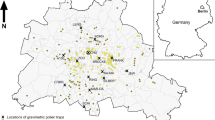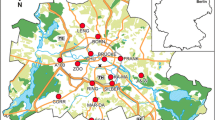Abstract
Humans now spent most of their time indoor where they can be exposed to various aerocontaminants, among which pollen. The question of remanence of pollen grains indoor is important because allergic patients could get symptoms from these indoor pollen far away from the pollination period but the temporal relationship between both phenomenons is poorly documented. In this study, we monitored pollen counts both in house dust samples and outdoor pollen traps during the whole pollen season in Southern France and computed the influx and remanence of various pollen species throughout the pollen season. Five families living in the same street volunteered to participate. Monitoring of indoor pollen counts was performed at four occasions through sampling of house dust from the living room. During the same period, outdoor pollen counts were monitored using a Burkard pollen trap. Pollens from 73 taxa were identified on the house dust samples collected indoor. For each pollen type, indoor pollen count dynamics were consistent with the observed pollen counts in Burkard traps over the whole pollination period. Two groups of pollen types can be defined on the basis of these results: the first group includes Platanus, Quercus and Cupressaceae which exhibit high remanence and a low penetration, and the second group contains species with high penetration but various remanence. Date of sampling was the main factor affecting penetration coefficients very low in winter, to moderate in spring and huge in summer. Pollen type, housing and sampling time period have bearing on penetration and remanence of pollen grains indoor.


Similar content being viewed by others
References
Ariano, R., Mistrello, G., Mincigrucci, G., Bricchi, E., Lannotti, O., Frenguelli, G., et al. (2006). In vitro and in vivo biological activities of old and fresh Cupressus arizonica pollen. Journal of Investigational Allergology and Clinical Immunology, 16, 177–182.
Bıçakçı, A., Olgun, G., Aybeke, M., Erkan, P., & Malyer, H. (2004). Analysis of airborne pollen fall in Edirne, Turkey. Acta Botanica Sinica, 46(10), 1149–1154.
Chang, C., & Gershwin, M. E. (2004). Indoor air quality and human health: Truth versus mass hysteria. Clinical Reviews in Allergy & Immunology, 27, 219–239.
D’Amato, G., Russo, M., Liccardi, G., Saggese, M., Gentili, M., Mistrello, G., et al. (1996). Comparison between outdoor and indoor airborne allergenic activity. Annals of Allergy, Asthma & Immunology, 77, 147–152.
Enomoto, T., Onishi, S., Sogo, H., Dake, Y., Ikeda, H., Funakoshi, H., et al. (2004). Japanese cedar pollen in floating indoor house dust after a pollinating season. Allergology International, 53, 219–225.
Farrera, I., Calleja, M., & Déchamp, C. (2002). Indoor and outdoor pollen sedimentation in the Rhone-Alpes region during the ragweed pollination season. Revue Française d’Allergologie et d’Immunologie Clinique, 42, 750–753.
Fredh, D., Broström, A., Rundgren, M., Lagerås, P., Mazier, F., & Zillén, L. (2012). The impact of land-use change on floristic diversity at regional scale in southern Sweden 600 BC–AD 2008. Biogeosciences, 10, 3159–3173.
Grinshpun, A., Lee, T., Martuzevicius, D., Adhikari, A., & Reponen, T. (2005). Relationship between indoor and outdoor exposure to airborne fungi and pollen in single-family homes, in indoor air 2005. In X. Yang, B. Zhao, & R. Zhao (Eds.), Proceedings of the 10th international conference on indoor air quality and climate (Beijing, China September 4–9, 2005) (pp. 1734–1738). Beijing: Tsinghua University Press.
Hirst, J. H. (1952). An automatic volumetric spore trap. Annals of Applied Biology, 39, 257–265.
Hugg, T., & Rantio-Lehtimäki, A. (2007). Indoor and outdoor pollen concentrations in private and public spaces during the Betula pollen season. Aerobiologia, 23, 119–129.
Jantunen, J., & Saarinen, K. (2009). Intrusion of airborne pollen through open windows and doors. Aerobiologia, 25, 193–201.
Lacey, M., & West, J. S. (2007). The air spora: A manual for catching and identifying airborne biological particles. Berlin: Springer.
Lebowitz, M. D., O’Rourke, M. K., Dodge, R., Holberg, G., Hoshaw, R., Pinnas, J., et al. (1982). The adverse health effects of biological aerosols, other aerosols, and indoor microclimate on asthmatics and non asthmatics. Environment International, 8, 375–380.
Lee, T., Grinshpun, S. A., Martuzevicius, D., Adhikari, A., Crawford, C. M., Luo, J., & Reponen, T. (2006). Relationship between indoor and outdoor bioaerosols collected with a button inhalable aerosol sampler in urban homes. Indoor Air, 16, 37–47.
Mandrioli, P., Comtois, P., Dominiquez-Vilches, E., Galan Soldevilla, C., Syzdek, L. D., & Issard, S. A. (1998). Sampling principles and techniques. In P. Mandrioli, P. Comtois, & V. Levizzani (Eds.), Methods in aerobiology (pp. 47–112). Bologna: Pitagora Editrice.
Matthias, I., Nielsen, A. B., & Giesecke, T. (2012). Evaluating the effect of flowering age and forest structure on pollen productivity estimates. Vegetation History Archaeobotany, 21, 471–484.
McMillan, A. (2013). A GIS approach to palaeovegetation modelling in the Mediterranean: The case study of southwest Turkey. Ph.D. Thesis, University of Birmingham.
O’Rourke, M. K., & Lebowitz, M. D. (1984). A comparison of regional atmospheric pollen with pollen collected at or near homes. Grana, 23, 55–64.
O’Rourke, M. K., Ouackenboss, J. J., & Lebowitz, M. D. (1989). An epidemiological approach investigating respiratory disease response in sensitive individuals to indoor and outdoor pollen exposure in Tucson, Arizona. Aerobiologia, 5, 104–110.
Saarinen, K., Jantunen, J., & Haahtela, T. (2011). Pollen transport by clothes. Aerobiologia, 27, 339–343.
Shahali, Y., Brazdova, A., Calleja, M., Charpin, D., & Poncet, P. (2013). Indoor long-term persistence of cypress pollen allergenic potency: A 10-month study. Annals of Allergy, Asthma & Immunology, 111, 428–430.
Sharma, D., Dutta, B. K., & Singh, A. B. (2009). Pollen, fungus and house dust mites survey at the residence of 90 allergic patients in Greater Silchar Area of Assam, India. Research Journal of Allergy, 1, 1–11.
Stock, T. H., & Morandi, M. T. (1988). A characterisation of indoor and outdoor microenvironmental concentration of pollen and spores in two Houston neighbourhoods. Environment International, 14, 1–9.
Takayashi, Y., Tanako, K., Suzuki, M., Nagai, S., Yokosuka, M., Takeshita, T., et al. (2009). Two routes for pollen entering indoors: Ventilation and clothes. Journal of Investigational Allergology Clinical Immunology, 18, 382–388.
Tormo-Molina, R., Gonzalo-Garigo, A., Silva-Palacio, I., & Fernandez-Rodriguez, S. (2009). Seasonal and spatial variations of indoor pollen in a hospital. International Journal of Environmental Research and Public Health, 6, 3169–3178.
Williams, C. G. (2008). Aerobiology of Pinus taeda pollen clouds. Canadian Journal of Forest Research, 38, 2177–2188.
Zeghnoun, A., Dor, F., & Grégoire, A. (2010). Description du budget espace temps et estimation de l’exposition de la population française dans son logement. Rapport de l’Observatoire de la qualité de l’air intérieur, pp. 49.
Acknowledgments
This work was funded by AFSSET contract EST-2006-1-35.
Author information
Authors and Affiliations
Corresponding author
Rights and permissions
About this article
Cite this article
Pichot, C., Calleja, M., Penel, V. et al. Inference of the pollen penetration and remanence into dwellings using seasonal variation of indoor/outdoor pollen counts. Aerobiologia 31, 315–322 (2015). https://doi.org/10.1007/s10453-015-9366-6
Received:
Accepted:
Published:
Issue Date:
DOI: https://doi.org/10.1007/s10453-015-9366-6




